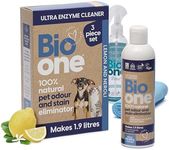Buying Guide for the Best Enzyme Pet Cleaner
Choosing the right enzyme pet cleaner is crucial for maintaining a clean and odor-free home, especially if you have pets. Enzyme cleaners are designed to break down organic materials, such as pet urine, feces, and vomit, effectively removing stains and odors. When selecting an enzyme pet cleaner, it's important to consider the specific needs of your household and pets, as well as the surfaces you will be cleaning. Understanding the key specifications will help you make an informed decision and ensure you choose a product that meets your cleaning requirements.Enzyme TypeEnzyme type refers to the specific enzymes used in the cleaner to break down organic materials. Different enzymes target different types of stains and odors. For example, proteases break down proteins, amylases target starches, and lipases work on fats. It's important to choose a cleaner with the right enzyme type for the specific messes you encounter. If your pet frequently has accidents involving urine, look for a cleaner with enzymes that target uric acid. For a variety of messes, a multi-enzyme formula might be the best choice.
Surface CompatibilitySurface compatibility indicates which surfaces the cleaner can be safely used on, such as carpets, hardwood floors, upholstery, or tile. This is important because using the wrong cleaner on a surface can cause damage or discoloration. To choose the right cleaner, consider the surfaces in your home where pet accidents are most likely to occur. If you have a mix of surfaces, look for a versatile cleaner that is safe for multiple types of materials. Always check the label for specific surface recommendations.
ScentThe scent of an enzyme pet cleaner can affect the overall freshness of your home. Some cleaners have added fragrances to leave a pleasant smell after cleaning, while others are unscented to avoid overwhelming sensitive noses. If you or your pets are sensitive to strong scents, an unscented or lightly scented cleaner may be preferable. On the other hand, if you want to mask odors while the enzymes work, a cleaner with a fresh scent might be more suitable. Consider your personal preference and any sensitivities when choosing a scent.
Application MethodThe application method refers to how the cleaner is applied to the affected area. Common methods include spray bottles, pour bottles, or concentrates that need to be diluted. The application method can impact ease of use and effectiveness. For quick and easy spot cleaning, a spray bottle might be the most convenient. If you need to cover larger areas, a pour bottle or concentrate might be more economical. Consider how you plan to use the cleaner and choose an application method that fits your cleaning routine.
Drying TimeDrying time is the amount of time it takes for the cleaner to dry after application. This is important because it affects how quickly you can use the cleaned area again. Shorter drying times are generally more convenient, especially in high-traffic areas. However, some cleaners may require longer drying times to fully break down stains and odors. Consider your schedule and the areas you need to clean when evaluating drying times. If you need quick results, look for a cleaner with a faster drying time.















